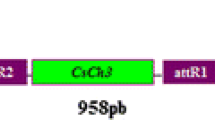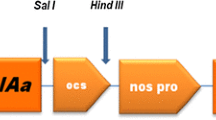Summary
Transgenic head cabbage (Brassica oleracea var. capitata), resistant to diamondback moth (Plutella xylostella) larvae, was developed through Agrobacterium tumefaciens-mediated transformation with Bacillus thuringiensis (Bt) cry genes using a modified procedure. Factors important for transformation included cabbage cultivar; preculture and coculture of explants on a callus initiation medium; use of appropriate amount; and delay in initial application of selective agents. A total of 15 independent transformed lines with over 100 plants were obtained from several transformation experiments, representing an overall transformation efficiency of ∼1%. Cabbage plants transformed with a synthetic Bt gene, cry1Ab3, were all resistant to larvae of the diamondback moth, whereas all plants transgenic for cryIIa3, a wild-type Bt gene, were susceptible. As a first step towards testing the hypothesis that reduced exposure of Bt to target insects would delay the evolution of insect resistance to Bt, cry1Ab3 expression was put under the transcriptional control of the soybean wound-inducible vspB promoter and transgenic cabbage was obtained. Insect bioassay showed that such plants were all resistant to diamondback moth even without induction for the expression of Bt.
Similar content being viewed by others
References
Berthomieu, P.; Béclin, C.; Charlot, F.; Doré, C.; Jouanin, L.. Routine transformation of rapid cycling cabbage (Brassica oleracea)—molecular evidence for regeneration of chimeras. Plant Sci. 96:223–235; 1994.
Berthomieu, P.; Jouanin, L. Transformation of rapid cycling cabbage (Brassica oleracea var. capitata) with Agrobacterium rhizogenes. Plant Cell Rep. 11:334–338; 1992.
Christey, M. C.; Sinclair, B. K.; Braun, R. H. Regeneration of transgenic vegetable brassicas (Brassica oleracea and B. campestris) via Rimediated transformation. Plant Cell Rep. 16:587–593; 1997.
Crickmore, N.; Zeigler, D. R.; Feitelson, J.; Schnepf, E.; Van Rie, J.; Lereclus, D.; Baum, J.; Dean, D. H. Revision of the nomenclature for the Bacillus thuringiensis pesticidal crystal proteins. Microbiol. Mol. Biol. Rev. 62:807–813; 1998.
Diehn, S. H.; Chiu, W.-L.; Rocher, E. J. D.; Green, P. J. Premature polyadenylation at multiple sites within a Bacillus thuringiensis toxin gene-coding region. Plant Physiol. 117:1433–1443; 1998.
Doyle, J. D.; Doyle, J. L., Isolation of plant DNA from fresh tissue. Focus 12:13–15; 1990.
Eimert, K.; Siegemund, F. Transformation of cauliflower (Brassica oleracea L. var. botrytis)—an experimental survey. Plant Mol. Biol. 19:485–490; 1992.
Gamborg, O. L.; Miller, R. A.; Ojima, K., Nutrient requirement of suspension cultures of soybean root cells. Exp. Cell Res. 50:151–158; 1968.
Gatz, C. Chemical control of gene expression. Annu. Rev. Plant Physiol. Plant Mol. Biol. 48:89–108; 1997.
Gelvin, S. B.; Liu, C.-N., Genetic engineering of Agrobacterium tumefaciens strains to improve transformation of recalcitrant plant species. In: Gelvin, S. B.; Schilperoort, R. A., eds. Plant molecular biology manual, Dordrecht, The Netherlands; Kluwer Academic; 1994; 1–13.
Holsters, M.; de Waele, D.; Depicker, A.; Messens, E.; Van Montagu, M.; Schell, J. Transfection and transformation of Agrobacterium tumefaciens. Mol. Gen. Genet. 163:181–187; 1978.
Hood, E. E.; Gelvin, S. B.; Melchers, L. S.; Hoekema, A. New Agrobacterium helper plasmids for gene transfer to plants. Transgen. Res. 2:208–218; 1993.
Jin, R.-G.; Liu, Y.-B.; Tabashnik, B. E.; Borthakur, D., Tissue culture and Agrobacterium-mediated transformation of watereress. Plant Cell Tiss. Org. Cult. 58:171–176; 1999.
Koziel, M. G.; Beland, G. L.; Bowman, C.; Carozzi, N. B.; Crenshaw, R.; Crossland, L.; Dawson, J.; Desai, N.; Hill, M.; Kadwell, S.; Launis, K.; Lewis, K.; Maddox, D.; McPherson, K.; Meghji, M. R.; Merlin, E.; Rhodes, R.; Warren, G. W.; Wright, M.; Evola, S. V., Field performance of elite transgenic maize plants expressing an insecticidal protein derived from Bacillus thuringiensis. Bio/Technol. 11:194–200; 1993.
Liu, Y.-B.; Tabashnik, B. E. Experimental evidence that refuges delay insect adaptation to Bacillus thuringiensis. Proc. R. Soc. Lond. B. 264:605–610; 1997.
Liu, Y.-B.; Tabashnik, B. E., Elimination of a recessive allele conferring resistance to Bacillus thuringiensis from a heterogeneous strain of diamondback moth (Lepidoptera: Plutellidae). J. Econ. Entomol. 91:1032–1037; 1998.
Mason, H. S.; Mullet, J. E., Expression of two soybean vegetative storage protein genes during development and in response to water deficit, wounding, and jasmonic acid. Plant Cell 2:569–579; 1990.
Metz, T. D.; Dixit, R.; Earle, E. D., Agrobacterium tumefaciens-mediated transformation of broccoli (Brassica oleracea var. italica) and cabbage (B. oleracea var. capitata) Plant Cell Rep. 15:287–292; 1995.
Murashige, T.; Skoog, F. A revised medium for rapid growth and bioassay with tobacco tissue culture. Physiol. Plant 15:473–497; 1962.
Ovesná, J.; Ptacek, L.; Opatrny, Z., Factors influencing the regeneration capacity of oilseed rape and cauliflower in transformation experiments. Biologia Plant 35:107–112; 1993.
Passelègue, E.; Kerlan, C. Transformation of cauliflower (Brassica oleracea var. botrytis) by transfer of cauliflower mosaic virus gene through cocultivation with virulent and avirulent strains of Agrobacterium. Plant Sci. 113:79–89; 1995.
Pawlowski K.; Kunze, R.; Vries, S.; Bisseling, T., Isolation of total, poly(A) and polysomal RNA from plant tissues. In: Gelvin, S. B.; Schilperoort, R. A., eds. Plant molecular biology manual. Dordrecht, The Netherlands: Kluwer Academic; 1994; 2–4.
Peferoen, M. Progress and prospects for field use of Bt genes in crops. Tibtech. 15:173–177; 1997.
Pua, E. C.; Mehra-Paita, A.; Nagy, F.; Chua, N. H. Transgenic plants of Brassica napus L., Bio/Technol. 5:815–817; 1987.
Puddephat, I. J.; Riggs, T. J.; Fenning, T. M. Transformation of Brassica oleracea L: a critical review. Mol. Breed. 2:185–210; 1996.
Rocher, E. J. D.; Vargo-Gogola, T. C.; Diehn, S. H.; Green, P. J. Direct evidence for rapid degradation of Bacillus thuringiensis toxin mRNA as a cause of poor expression in plants. Plant Physiol. 117:1445–1461; 1998.
Shin, B.-S.; Park, S.-H.; Choi, S.-K.; Koo, B.-T.; Lee, S.-T.; Kim, J.-I. Distribution of cry V-type insecticidal protein genes in Bacillus thuringiensis and cloning of cryV-type genes from Bacillus thuringiensis subsp, kurstaki and Bacillus thuringiensis subsp. entomocidus. Appl. Environ. Microbiol. 61:2402–2407; 1995.
Srivastava, V.; Reddy, A. S.; Guha-Mukhejee, S., Transformation and regeneration of Brassica oleracea mediated by an oncogenic Agrobacterium tumefaciens. Plant Cell Rep. 7:504–507; 1988.
Tabashnik, B. E. Evolution of resistance to Bacillus thuringiensis. Annu. Rev. Entomol. 39:47–79; 1994.
Tabashnik, B. E.; Liu, Y.-B.; Malvar, T.; Heckel, D. G.; Masson, L.; Ballester, V.; Granero, F.; Mènsua, J. L.; Ferrè, J. Global variation in the genetic and biochemical basis of diamondback moth resistance to Bacillus thuringiensis. Proc. Natl Acad. Sci. U.S.A. 94:12780–12785; 1997.
Tabashnik, B. E.; Malvar, T.; Liu, Y.-B.; Borthakur, D.; Shin, B. S.; Park, S. H.; Masson, L.; de Maagd, R. A.; Bosch, D. Cross-resistance of diamondback moth indicates altered interactions with domain II of Bacillus thuringiensis toxins. Appl. Environ. Microbiol. 62:2839–2844; 1996.
Talekar, N. S.; Shelton, A. M. Biology, ecology, and management of diamondback moth. Annu. Rev. Entomol. 38:275–301; 1993.
Tang, J. D.; Gilboa, S.; Roush, R. T.; Shelton, A. M. Inheritance, stability, and lack-of-fitness costs of field-selected resistance to Bacillus thuringiensis in diamondback moth (Lepidoptera: Plutellidae) from Florida. J. Econ. Entomol. 90:732–741; 1997.
Tepfer, D. Ri T-DNA from Agrobacterium rhizogenes: a source of genes having applications in rhizosphere biology and plant development, ecology, and evolution. In: Kosuge, T.; Nester, E. W., eds. Plantmicrobe interactions. Molecular and genetic perspectives, Vol. 3, New York, U.S.A.: McGraw-Hill; 1989; 294–342.
Thomzik, J. E., Transformation in oilseed rape (Brassica napus L) In: Bajaj, Y. P. S., ed. Plant protoplasts and genetic enginerring. IV. Biotechnology in agriculture and forestry, Vol. 23, Berlin/Heidelberg, Germany: Springer-Verlag; 1993; 170–182.
Toriyama, K.; Stein, J. C.; Nasrallah, M. E.; Nasrallah, J. B. Transformation of Brassica oleracea with an S-locus gene from B. campestris changes the self-incompatibility phenotype. Theor. Appl. Genet. 81:769–776; 1991.
Trail, F.; Richards, C.; Wu, F.-S., Genetic manipulation in Brassica. In: Bajaj, Y. P. S., ed. Plant protoplasts and genetic engineering. II. Biotechnology in agriculture and forestry, Vol. 9, Berlin/Heidelberg, Germany: Springer-Verlag; 1989; 197–215.
Wünn, J.; Klöti, A.; Burkhardt, P. K.; Biswas, G. C. G.; Launis, K.; Iglesias, V. A.; Potrykus, I. Transgenic Indica rice breeding line IR58 expressing a synthetic cryA(b) gene from Bacillus thuringiensis provides effective insect pest control. Bio/Technol. 14:171–176; 1996.
Author information
Authors and Affiliations
Corresponding author
Rights and permissions
About this article
Cite this article
Jin, R.G., Liu, Y.B., Tabashnik, B.E. et al. Development of transgenic cabbage (Brassica oleracea var. Capitata) for insect resistance by Agrobacterium tumefaciens-mediated transformation. In Vitro Cell.Dev.Biol.-Plant 36, 231–237 (2000). https://doi.org/10.1007/s11627-000-0043-1
Received:
Accepted:
Issue Date:
DOI: https://doi.org/10.1007/s11627-000-0043-1




